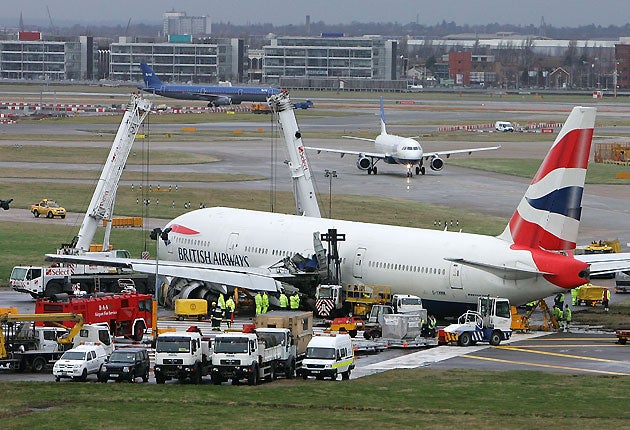Ice 'probable cause' of Heathrow crash-landing

Plane safety requirements did not cover the particular ice problem which probably caused a Boeing 777 to crash-land at Heathrow Airport two years ago as the risk was "unrecognised at that time", an official accident report said today.
The crash of the British Airways 777 on January 17 2008 came after the plane lost power due to a restricted fuel flow to both engines, a final report from the Air Accidents Investigation Branch (AAIB) said.
The AAIB concluded it was probable that the engine fuel flow restriction was caused by a build-up of ice within the fuel system on the flight on which 136 passengers were travelling.
The report said it was also probable that ice had formed within the fuel system from water that occurred naturally in the fuel and when fuel temperatures were at a "sticky range" when ice crystals were most likely to adhere to their surroundings.
The AAIB said: "Certification requirements, with which the aircraft and engine fuel system had to comply, did not take account of this phenomenon as the risk was unrecognised at that time."
The report added that research in the 1950s had identified the problem of ice formation in fuel systems from dissolved or entrained (trapped) water but did not identify the scenario of accumulated ice release and subsequent restriction to fuel flow.
The AAIB concluded that the engine component called the fuel oil heat exchanger on the crashed Boeing was susceptible to restriction where presented with soft ice in a high concentration and with a fuel temperature that was below minus 10C (14F).
The AAIB added there were no published guidelines or tests on the susceptibility of a fuel system to ice.
Having lost power, the BA plane, arriving from Beijing, came down within the airfield boundary at Heathrow but 330 metres short of the paved runway, sliding 372 metres before coming to rest.
The left main landing gear (MLG) collapsed and the right MLG separated from the plane. All the passengers were safely evacuated, with one passenger breaking a leg. All told, 34 passengers and 12 cabin crew suffered minor injuries, mainly to the back and neck.
The report said that the cabin crew, led by Captain Peter Burkill, had become aware of a possible engine thrust problem just 43 seconds from touchdown.
Losing speed, the crew tried to increase engine thrust but there was no response from the engines. With a touchdown short of the runway inevitable, a Mayday call put out three second before touchdown.
There was insufficient time for the flight crew to brief the cabin crew or issue a command for passengers to brace themselves, the report said.
There was no fire but there was a significant fuel leak, while there was also an oxygen leak caused by damage to the passenger oxygen bottles from part of the MLG.
The AAIB said some passengers attempted to retrieve personal items during the evacuation.
On November 28 2008 a Delta Airlines Boeing 777 suffered a similar ice problem while flying over the USA, which prompted an investigation by America's National Transportation Safety Board, with the AAIB having an accredited representative.
In both the BA and Delta incidents the power loss - or "engine rollback" - came when the fuel temperature was minus 22C (minus 7.6F).
Nine safety recommendations were made following the earlier AAIB reports into the BA incident. Boeing and aero engine company Rolls-Royce took steps to prevent the ice phenomenon from re-occurring.
Today, the AAIB made nine further safety recommendations, including some which address plane "crashworthiness" - the ability of an aircraft to withstand an accident.
A British Airways spokesman said: "We welcome this final report. The crew of BA38 did a fantastic job in extremely difficult circumstances. They displayed the highest levels of professionalism and all crew members were awarded the company's highest accolade, the BA safety medal.
"We have given our full support and cooperation throughout the AAIB investigation and recognise that it has been conducted in a thorough and professional manner."
BA added that although there were no specific safety recommendations for the airline, it had worked with the relevant authorities and manufacturers "to ensure that the highest safety levels are maintained".
BA went on: "As with other operators of Boeing 777s powered by Rolls-Royce Trent 800 engines, and in accordance with the safety recommendations to the aviation authorities and manufacturers, we have put in place a number of additional operational procedures and checks since the AAIB investigation began in January 2008 to prevent a recurrence.
"We installed the redesigned fuel oil heat exchangers (FOHEs) on all of our Boeing 777s powered by Trent 800 engines by October 2009. At that stage we lifted the remaining operational procedure that had been put in place as a precaution pending the completion of the redesigned FOHEs.
"Our customers can continue to fly with British Airways safe in the knowledge that our aircraft are operated and maintained to the very highest standards. The safety of our customers and staff is always our over-riding priority and we would never do anything to compromise it."
Subscribe to Independent Premium to bookmark this article
Want to bookmark your favourite articles and stories to read or reference later? Start your Independent Premium subscription today.

Join our commenting forum
Join thought-provoking conversations, follow other Independent readers and see their replies